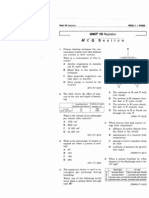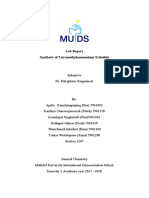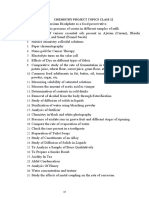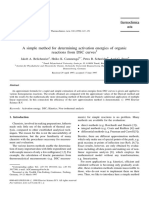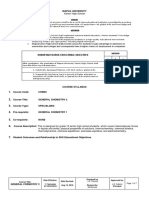CAPE 2009 Unit 1 Solutions
CAPE 2009 Unit 1 Solutions
Uploaded by
Nikoli MajorCopyright:
Available Formats
CAPE 2009 Unit 1 Solutions
CAPE 2009 Unit 1 Solutions
Uploaded by
Nikoli MajorOriginal Description:
Copyright
Available Formats
Share this document
Did you find this document useful?
Is this content inappropriate?
Copyright:
Available Formats
CAPE 2009 Unit 1 Solutions
CAPE 2009 Unit 1 Solutions
Uploaded by
Nikoli MajorCopyright:
Available Formats
CAPE: UNIT 1: MAY 2009: PAPER 2
SECTION A: MODULE 1
1. (a) Each element has a characteristic “fingerprint” line emission spectrum. Niels Bohr, in 1913,
proposed an explanation for the emission spectrum of the elements.
(i) State the property of elements which is responsible for the characteristic line spectrum
of each element [1 mark]
Answer: Each element has a unique number of electrons which allows for absorption of light of
specific wavelength.
How to get there:
Almost every human has a unique fingerprint. In the same way, the emission spectrum
of one element is unique, or different from that of any other element. This is what the
question means by “fingerprint” line emission spectrum.
Elements are made up of protons, neutrons and electrons. The number of each of these
is unique to each element.
However, electrons are the particles that are always in motion. They are able to absorb
energy, and to release energy. By measuring the energy released, a line emission
spectrum can be created.
Thus, electrons are the particles which generate line emission spectra.
Since each element has a unique number and arrangement of electrons, this is what
makes each line emission spectrum different.
(ii) Sketch a diagram of the line emission spectrum of hydrogen. On your diagram, indicate
the direction of increasing frequency and increasing wavelength [3 marks]
Answer:
Increasing frequency
Indigo
Green
Violet
Red
410 nm 434 nm 486 nm 656 nm
Increasing wavelength
UV Visible Infra red
CAPE 2009 UNIT 1 Page | 1
How to get there:
When electrons in a fixed energy level are heated, they are supplied with energy. They
can jump to a higher energy level. When they return to their original energy level, the
energy which had been supplied to them is given off (in the form of radiation). This
radiation is of a specific frequency.
Each frequency corresponds to a specific color.
Since frequency = speed/wavelength, (if speed is constant), this means that as
wavelength increases, the frequency will decrease.
(iii) Explain, in terms of electronic transitions, the origin of the lines in the Balmer series
[4 marks]
Answer:
When an atom is supplied with energy, the electrons become excited. The electrons are
promoted to higher energy levels, and in this excited state, the atom is unstable. There will be a
strong tendency for the electrons to re-emit energy to go to the ground level.
The emission of energy as the electrons are demoted to n=2, is now emitted in the form of
radiation. This radiation corresponds to a specific frequency, which is seen as a specific color.
The higher frequency lines will be of shorter wavelengths will be for bigger jumps. The lines will
be converging.
(iv) State the region of the electromagnetic spectrum in which the lines in the Balmer series
occur [1 mark]
Answer: The visible region
How to get there:
Since colors can be seen, this means that the Balmer series lines can be seen. This
means the lines are in the visible region of the spectrum
(v) Calculate the energy (E) of a quantum of radiation with a corresponding frequency (ν) of
4.57 x 1014 Hz. (h = 4 x 10-13 KJsmol-1)
Answer: Using E = hν where h= 4 x 10-13 KJsmol-1 and ν = 4.57 x 1014 s-1
CAPE 2009 UNIT 1 Page | 2
E = (4 x 10-13 KJsmol-1 ) (4.57 x 1014 s-1)
= 182.8 KJmol-1
How to get there:
This equation draws on the use of Planck’s constant (h)
Since E is measured in KJ per mole, we must try to eliminate the seconds from the
calculation
Since 1 Hz = 1s-1,
This means: 4.57 x 1014 Hz = 4.57 x 1014 s-1
(b) Figure 1 represents the apparatus assembled by a student for the experimental determination of the
heat of combustion of ethanol.
Identify FOUR errors in the assembly of the apparatus in Figure 1.
Answer:
Thermometer is touching walls of container
The bulb of the thermometer is not fully immersed in the water
Ethanol is being heated on an open flame, and should be contained in a spirit lamp
Use a heat shield
Heat is being lost, as the distance between the burning ethanol and the water is too great
How to get there:
In order to find the heat of combustion of ethanol, the ethanol should be burned in a spirit
lamp. This is safer than heating on an open flame, as ethanol is very flammable.
CAPE 2009 UNIT 1 Page | 3
The can of water to be heated should be placed as close as possible to the spirit lamp, such that
heat loss is minimized
The thermometer records readings of temperature change. To be accurate, the bulb should be
fully immersed in the solution. It should not touch the walls or the bottom of the metal can.
SECTION A: MODULE 2
2. (a) State TWO factors which affect reaction rates [2 marks]
Answer: Use of a catalyst, changes in temperature, concentration of reactants, physical state of
reactants, surface area to volume ratio of reactants, pressure of reactants (only if reactants are
gases), light for photochemical reactions
How to get there:
All of these factors are directly recalled as affecting the rate of reactions.
(b) The data in Table 1 were obtained for the decomposition of nitrogen dioxide at 673K.
NO2 (g) NO (g) + ½ O2 (g)
(i) Complete Table 1 by writing the missing values for 1/[NO 2] [2 marks]
TABLE 1: DECOMPOSITION OF NITROGEN DIOXIDE
Time (s) [NO2] moldm-3 1/[NO2] mol-1dm3
0.0 0.0100 100
50.0 0.00787 127
100.0 0.00649 154
200.0 0.00481 208
300.0 0.00380 263
How to get there:
The missing values are calculated by:
Dividing 1 by 0.00787 (1/0.00787) on your calculator
CAPE 2009 UNIT 1 Page | 4
Dividing 1 by 0.00481 (1/0.00481) on your calculator
The answers are to zero decimal places, in keeping with the values given for this column
(ii) Plot a graph of 1/[NO2] against time, on the grid below. The first and last points have
been plotted on the grid [2 marks]
Answer: This should yield a straight line graph.
How to get there:
Each major unit on the y axis represents 75 mol -1dm3.
At 50 seconds, the y coordinate should be 5.5 lines higher than the 100 marker
At 100 seconds, the y coordinate should be 11 lines higher than the 100 marker
At 200 seconds, the y coordinate should be 1.5 lines higher than the 200 marker
(iii) From your graph, determine the order of reaction with respect to NO 2. Give a reason for
your answer.
Order of reaction: 1st order [1 mark]
Reason: There is a straight line (direct proportional relationship) between the 1/[NO 2]
and time [1 mark]
CAPE 2009 UNIT 1 Page | 5
How to get there:
Since NO2 is a reactant, as time increases, the concentration of NO 2 is expected to
decrease (since it is being used up to form products).
In this question, 1/[NO2] was first calculated.
As [NO2] decreases, 1/[NO2] increases. This was seen in the table of values calculated.
Since 1/[NO2] increased proportionally with time, it was clearly seen that this was a first
order reaction.
(iv) State the rate law for the reaction [1 mark]
Answer: Rate = k [NO2(g)]
How to get there:
Rate Law is the same as a Rate Equation.
The Rate Law expression always begins with “Rate = k”
This is followed by the reactant being investigated, and the order of that reactant with
respect to rate. This gives us “Rate = k[NO 2]”
Although there is no number outside of the square brackets, it is understood that the
reaction is first order with respect to NO 2.
(v) Use the slope of the graph to determine the value and units of the rate constant, k for
the reaction [2 marks]
Answer: Using slope = y2-y1 = 208-127 = 81 mol -1dm3 = 0.54 mol-1dm3s-1
x2-x1 200-50 150s
How to get there: (Use Rate Equation to find k)
The slope or gradient is calculated by the given formula
y coordinates are substituted into the equation
The corresponding x coordinates are also substituted into the equation
There are no units common to the denominator and numerator, so there is no
cancelling of units.
In the denominator seconds (s) was to the power of +1. When it is placed in the
numerator position, its power changes to -1.
CAPE 2009 UNIT 1 Page | 6
(c) Several experimental methods, including titrimetry, can be used to determine reaction rates.
Suggest TWO other methods which can be used to determine reaction rates [2 marks]
Answer:
1. If products are gaseous, use a gas syringe to measure the rate at which gases are produced.
2. Pressure changes in gases
3. Remove samples of reaction mixture at intervals and titrate to determine how much reactant
has already reacted and how much still remains
4. If one of the products or reactants is colored, a colorimeter can be used to measure rate.
5. Changes in mass- of ppt formed
How to get there:
These methods can be directly recalled
(d) Outline TWO experimental steps in the determination of the reaction rate of an esterification
reaction using titrimetry [2 marks]
Answer: Esterification Reaction: Ethanoic Acid + Methanol Methyl ethanoate + Water
The standard solutions of acid and alcohol will be combined together.
After specific, regular time intervals, specific volumes of the mixture will be removed.
These will be titrated against a known volume of a standard solution of a base.
This will tell the concentration of the acid at each specific time interval
How to get there:
If the initial concentration of ethanoic acid is known, and the concentration of the
acid is found at specific time intervals, the rate at which the concentration of the
acid is decreasing can be determined.
CAPE 2009 UNIT 1 Page | 7
SECTION A: MODULE 3
3. (a) Insert arrows in the relevant boxes in Figure 2 to show the electronic configuration of the
species [5 marks]
Answer:
Fe: [Ar] ↿⇂ ↿ ↿ ↿ ↿ ↿⇂
Ni2+: [Ar] ↿⇂ ↿⇂ ↿⇂ ↿ ↿
Cr: [Ar] ↿ ↿ ↿ ↿ ↿ ↿
Cu+: [Ar] ↿⇂ ↿⇂ ↿⇂ ↿⇂ ↿⇂
V4+: [Ar] ↿
Figure 2: Electronic configuration of different species
(b) Use the distribution in the d orbitals to account for color in transition metal ions [2 marks]
Answer: When the ligands bond to the central ion, the d orbital splits into two different energy
levels. Energy is absorbed from white light to bring about electron promotion. The d orbitals do
not contain exactly the same amount of energy. This means that some of the d orbitals are of
higher energy than others. Electrons can be promoted from a lower energy d orbital to a higher
energy d orbital, when they absorb energy. When they return to the lower energy d orbital,
energy is released. This energy corresponds to a specific frequency, which is seen as a specific
color. The color seen is the complement of the color that was absorbed.
(c)Account for the observation that Zn2+ compounds are normally colorless [2 marks]
Answer: The configuration of Zn2+ is [Ar] 3d10.
Since the orbitals are filled, no d-d transitions are possible, hence no absorption of white light.
No color is seen
CAPE 2009 UNIT 1 Page | 8
(d) Figure 3 refers to the following reaction scheme.
Figure 3: Reaction scheme
(i) Complete the table below by writing the color of the species labeled A, B, C, D and E in
Figure 3. [5 marks]
Species A B C D E
Color White Blue Blue Green or Black
yellow
(ii) Write the formula of Species E [1 mark]
Answer: CuO
How to get there:
Cu(OH)2 (s) Δ CuO (s) + H2O (g)
CAPE 2009 UNIT 1 Page | 9
SECTION B: MODULE 1
4. Valence Shell Electron Pair Repulsion (VSEPR) Theory is normally used to predict the shapes and
bond angles of simple molecules and ions.
(a) State the basic principle behind the VSEPR theory [1 mark]
Answer: The VSEPR Theory assumes that the electron pairs surrounding the central atom will
repel one another and try to get as far apart as possible.
(b) When hydrochloric acid reacts with water and ammonia, the corresponding hydroxonium
and ammonium ions are formed.
(i) Using the VSEPR theory, state the shapes of the hydroxonium (H 3O+) and ammonium (NH4+)
ions [2 marks]
Answer: H3O+ is pyramidal in shape and NH4+ is tetrahedral in shape
(ii) Using suitable diagrams, illustrate the shape of EACH ion in (b) (i) [2 marks]
Answer: Draw wedge and broken lines
H +
xx +
O N
H H
H H H H
(iii) Account for the shape of EACH of the species H 3O+ and NH4+ [4 marks]
Answer:
CAPE 2009 UNIT 1 Page | 10
Ion: NH4+ Ion: H3O+
Central atom: N Central atom: O
Electronic configuration: 2,5 (but since 1 electron Electronic configuration: 2,6 (but since 1 electron
is lost – 2,4). The positive sign tells this. is lost- 2,5). The positive sign tells this.
Surrounding atoms: H Surrounding atoms: H
Electronic configuration: 1 Electronic configuration: 1
Drawing: Drawing:
H
ex xx
H ex N ex H H ex O ex H
ex ex
H H
No. of negative centres: Four No. of negative centres: Four
No. of lone pairs: Zero No. of lone pairs: One
No. of bonding pairs: Four No. of bonding pairs: Three
Shape: Tetrahedral Shape: Pyramidal
Bond angle: 109o Bond angle: 108o
(c) Suggest an explanation for EACH of the following observations:
(i) The experimental determination of the relative molecular mass of ethanoic acid (CH 3CO2H) produces
a value of 120. Your answer should include a suitable diagram [4 marks]
Answer:
CAPE 2009 UNIT 1 Page | 11
The relative molecular mass of ethanoic acid is 60. However, as illustrated above, two acid molecules are
joined together by hydrogen bonds, forming a dimer. Between a pair of molecules, two hydrogen bonds
are formed. This causes the relative molecular mass to double.
Show partial charges on O and H on the hydroxyl group. Show intermolecular bond.
(ii) The boiling point of propanone (acetone) is greater than that of butane [2 marks]
Answer: The boiling point of a compound depends on the strength of its intermolecular forces. Butane
has weak Van der Waal intermolecular forces. In propanone, there are stronger permanent dipole,
permanent dipole forces of attraction between molecules. This means that butane will have the lower
boiling point.
Both have the same RMM. Draw structures of both molecules. Propanone is polar, while butane is non
polar.
SECTION B: MODULE 2
5. The following equation represents a step in the Contact Process for the manufacture of
sulphuric acid.
Equation 1: 2SO2 (g) + O2 (g) 2SO3 (g) ΔH = -196KJmol-1
(a) State Le Chatelier’s Principle [2 marks]
Answer: Le Chatelier’s principle states that “if a (reversible) chemical system in equilibrium is
subjected to a change, processes will occur which tend to counteract the change imposed such
that the reaction goes back into equilibrium.”
(b) State the effect of EACH of the following on the equilibrium position of the reaction in
Equation 1:
(i) An increase in pressure
CAPE 2009 UNIT 1 Page | 12
Answer: An increase in pressure will shift the equilibrium position to the right. There is a greater
volume of reactant molecules than product molecules.
(ii) An increase in temperature [2 marks]
Answer: Equilibrium shifts to the left.
Since the forward reaction is giving off heat (exothermic), it does not need any more heat.
Therefore, if temperature is increased, the reverse reaction is favored.
(c) (i) When SO2 and O2 are mixed in a 2:1 ratio, at 303K, the total equilibrium pressure of the
system is 101.3 KPa.
Calculate Kp at 303K for the reaction in Equation 1, if at equilibrium, the number of moles of
SO2, O2 and SO3 are 1.2, 0.6 and 0.8 respectively [4 marks]
Answer:
2SO2 (g) + O2 (g) 2SO3 (g)
No of moles Initially: 2 moles 1 mole 0 moles
At equilibrium: 1.2 moles 0.6 moles 0.8 moles
Total number of moles = 1.2 +0.6 + 0.8 =2.6 moles
Mole Fraction of SO2 = 1.2/2.6 = 0.46
Partial pressure of SO2 = 0.46 x 101.3 = 46.75 KPa
Mole Fraction of O2 = 0.6/ 2.6 = 0.23
Partial pressure of O2 = 0.23 x 101.3 = 23.38 KPa
Mole Fraction of SO3 = 0.8/ 2.6 = 0.308
Partial pressure of SO3 = 0.308 x 101.3 = 31.2 KPa
CAPE 2009 UNIT 1 Page | 13
Kp = (PSO3)2 = (31.2) 2 = 0.019 KPa-1
(PSO2)2 (PO2) (46.75)2 (23.38)
(ii) Comment on the value of Kp at 695K for the reaction in Equation 1. [1 mark]
Answer: When temperature increases, the reverse reaction is favored. The reactants become
the products. The products become the reactants. The value of Kp will now decrease. If the
equilibrium shifts, the numerator will decrease, and the denominator will increase.
(d) Consider the following equation for a reversible reaction.
Equation 2: H2S + H2O H3O+ + HS- Ka = 8.9 x 10-8
(i) Define the term “Bronsted-Lowry base” [1
mark]
Answer: A base is a proton (H+ ) acceptor
(ii) Identify TWO bases in Equation 2 [2 marks]
Answer: H2O – It has accepted a proton (H+) to become H3O+
HS-– It has accepted a proton (H+) to become H2S
(e) Calculate the pH of a 0.05moldm-3 solution of Ba(OH)2 [3 marks]
Answer: Number of OH groups = 2
pH = -log (0.05 x 2) = 1
pOH = 14 –pH
= 14 -1 = 13
Write equation for dissociation:
Ba(OH)2 (s) Ba2+ (aq) + 2OH- (aq)
0.05 moldm-3 0.05 moldm-3 0.1moldm-3
CAPE 2009 UNIT 1 Page | 14
SECTION B: MODULE 3
6. (a) Define the term ‘electronegativity’ [1 mark]
Answer: The electronegativity of an atom provides a numerical measure of the power of that
atom in a molecule to attract the bonding electrons
(b) Consider the chlorides of the elements in Period 3 of the periodic table, and answer the
following questions:
(i) Describe the structures of the chlorides [2
marks]
Answer: NaCl and MgCl2 are both giant ionic structures consisting of a regular arrangement of
positive and negative ions. AlCl3, SiCl4, PCl3, S2Cl2 and Cl2 are all simple molecular structures
consisting of molecules held together by Van der Waal forces.
(ii) Describe the differences in the pH of the solutions formed when the chlorides react
with
water [2 marks]
Answer: NaCl and MgCl 2 both dissolve to form neutral solutions (pH =7). However all the other
Period 3 chlorides form acidic solutions, (approx pH 2-6)
(iii) Write the equation for the reaction of silicon (IV) chloride and water [2
marks]
Answer: SiCl4 (l)+ 4 H2O(l) Si(OH)4 (s) + 4 HCl (g)
(c) Chlorine forms a colorless solution, P, when dissolved in cold sodium hydroxide. This
reaction, which is represented by the reaction below, is referred to as disproportionation.
OH-
Cl2 (g) + 2OH- Cl- (aq) + ClO- (aq) + H2O (l)
H+
(i) What is meant by the term “disproportionation”? [1 mark]
CAPE 2009 UNIT 1 Page | 15
Answer: A reaction in which there is a change in which one particular (species) molecule, atom
or ion is simultaneously oxidized and reduced is called a disproportionation reaction.
(ii) A suspension is formed when excess silver ions (Ag +) are added to Solution P. On
filtering the suspension, and heating the filtrate, a white precipitate is formed.
Given the fact that the filtrate contains both Ag + and ClO- ions, account for the
presence of the white precipitate on heating [2 marks]
Answer: When heated, the ClO- ions decompose into Cl- ions. The Ag+ ions then combine with
the Cl- to form white AgCl (precipitate)
Include equation
(d) A simple salt, S, when treated with concentrated sulphuric acid produces dense white
fumes, T and a red brown gas, U.
T, on dissolving in water, produces a colorless solution which turns blue litmus paper red,
and gives a cream precipitate, V, on addition of silver ions. V dissolves in aqueous ammonia.
(i) Identify the substances T, U and V [3 marks]
Answer: If the salt is simple, it must contain one cation and one anion. The only anion which
reacts with concentrated sulphuric acid to produce two gases- one white and one red-
brown is the Br- ion.
The colorless gas (T) is HBr which is acidic (it turns blue litmus red)
The red-brown gas (U) is Br2
When silver ions (Ag+) are added to bromide ions (Br -), AgBr is formed. This is cream in color.
It is sparingly soluble in aqueous ammonia.
The cream precipitate is therefore AgBr
(ii) Write the formula for the ion present in S [1 mark]
Answer: The Br- ion is present
CAPE 2009 UNIT 1 Page | 16
(iii) Write the equation for the formation of the cream precipitate, V [1 mark]
Answer: Ag+ (aq) + Br- (aq) AgBr(s)
CAPE 2009 UNIT 1 Page | 17
You might also like
- Astm E698 16Document8 pagesAstm E698 16Rahul RameshNo ratings yet
- CAPE 2003 ChemistryDocument29 pagesCAPE 2003 ChemistrylzbthshayNo ratings yet
- Chemistry Past 10 Year Papers 2002-2013Document106 pagesChemistry Past 10 Year Papers 2002-2013siddharth199650% (2)
- Chemistry SBA P3 Jan 2015Document8 pagesChemistry SBA P3 Jan 2015ValNo ratings yet
- Chem 26.1 - Mock Formal ReportDocument6 pagesChem 26.1 - Mock Formal ReportAlexander Gordon InesNo ratings yet
- Classification of OrganismsDocument5 pagesClassification of Organisms言爱邦No ratings yet
- MOE-Trinidad and TobagoDocument85 pagesMOE-Trinidad and TobagoShenelle Avanna Lilly Jordan100% (5)
- Disaster Management Study Material I TestDocument17 pagesDisaster Management Study Material I TestnarenisursNo ratings yet
- Trends in Group 7..cape ChemistryDocument12 pagesTrends in Group 7..cape ChemistryOprahNo ratings yet
- Analysis of Hydrogen PeroxideDocument6 pagesAnalysis of Hydrogen PeroxideAhmad AlhamwiNo ratings yet
- The Common Ion EffectDocument24 pagesThe Common Ion EffectMothi KarunaNo ratings yet
- Self Purification of Natural SreamsDocument8 pagesSelf Purification of Natural SreamsरजतयदुवंशीNo ratings yet
- 200 Questions On Biology With ExplanationDocument39 pages200 Questions On Biology With ExplanationvgasNo ratings yet
- Chemistry SolutionsDocument104 pagesChemistry SolutionsFariza100% (1)
- Disaster Management Version 1.0Document205 pagesDisaster Management Version 1.0poojapriya204No ratings yet
- CAPE Chemistry Unit Two Paper OnesDocument153 pagesCAPE Chemistry Unit Two Paper OnesSam RamgatteeNo ratings yet
- CAPE Chemistry Unit 1Document15 pagesCAPE Chemistry Unit 1Audi SweetangelNo ratings yet
- Cape Chem U2 P2 2005Document10 pagesCape Chem U2 P2 2005Daniella SalandyNo ratings yet
- CSEC Chemistry MCQ - Answer KeyDocument52 pagesCSEC Chemistry MCQ - Answer KeyShaundelle BourneNo ratings yet
- Mega CAPE Unit 2 Bio P1 CollectionDocument267 pagesMega CAPE Unit 2 Bio P1 Collectiondabionmckenzie64No ratings yet
- Probablility - Chi SquareDocument13 pagesProbablility - Chi Squareron971No ratings yet
- Biology Notes Unit TwoDocument158 pagesBiology Notes Unit TwoBlohsh KeenenNo ratings yet
- Heat & Thermal MeasurementsDocument47 pagesHeat & Thermal Measurementskriston khanNo ratings yet
- CAPE Chemistry 2010 U2 P2Document14 pagesCAPE Chemistry 2010 U2 P2hahaNo ratings yet
- Biology Teachers' Manual PDFDocument72 pagesBiology Teachers' Manual PDFAndrewNo ratings yet
- CAPE Biology U1 P1 AnswersDocument1 pageCAPE Biology U1 P1 AnswersSashidaeNo ratings yet
- Cape Unit 1 - Lab Manual GouldDocument37 pagesCape Unit 1 - Lab Manual GouldTequan HolderNo ratings yet
- Solutions Manual Chapter 03Document28 pagesSolutions Manual Chapter 03Duy Pham TruongNo ratings yet
- Lesson 2 Non-Metals and Moles G11Document61 pagesLesson 2 Non-Metals and Moles G11Jodell CampbellNo ratings yet
- Mole CalculationsDocument27 pagesMole CalculationsAmyNo ratings yet
- CAPE June 2008chemistry RestofRegionSRDocument9 pagesCAPE June 2008chemistry RestofRegionSRtrudy-annNo ratings yet
- Additional Mathematics S.B.A (Kinematics)Document39 pagesAdditional Mathematics S.B.A (Kinematics)Danelia GordonNo ratings yet
- BIOLOGY UNIT 1 Module 2 QuestionsDocument10 pagesBIOLOGY UNIT 1 Module 2 QuestionsvictoriaNo ratings yet
- CAPE Caribbean Studies Solution 2008Document56 pagesCAPE Caribbean Studies Solution 2008SashidaeNo ratings yet
- Helpful For CAPE U1 Chemistry - Transition ElementsDocument30 pagesHelpful For CAPE U1 Chemistry - Transition ElementsDenison Dwarkah100% (1)
- Biology Unit 1 p2 2002Document8 pagesBiology Unit 1 p2 2002asjawolverineNo ratings yet
- Flashcards - Topic 1 Atomic Structure and The Periodic Table - Edexcel Chemistry A-LevelDocument131 pagesFlashcards - Topic 1 Atomic Structure and The Periodic Table - Edexcel Chemistry A-LevelHarriet StrattonNo ratings yet
- Chemistry Unit One LabsDocument14 pagesChemistry Unit One Labscarlissia wilkinsNo ratings yet
- Csec Biology Manual of Essential Notes Based Purely On Syllabus RequirementsDocument101 pagesCsec Biology Manual of Essential Notes Based Purely On Syllabus RequirementsZachary DomanNo ratings yet
- Csec Respiration (Multiple Choice)Document8 pagesCsec Respiration (Multiple Choice)Nikita Matthews100% (3)
- Acid Base EquilibriaDocument13 pagesAcid Base EquilibriaIlijah CorbinNo ratings yet
- CAPE Chemistry Unit2 Module3 Industry and The Environment 2016-2017Document24 pagesCAPE Chemistry Unit2 Module3 Industry and The Environment 2016-2017dela2No ratings yet
- Hess's Law and The Enthalpy of Combustion of MagnesiumDocument8 pagesHess's Law and The Enthalpy of Combustion of MagnesiumRabih Daoud100% (1)
- Meiosis LabDocument9 pagesMeiosis Labpeter103958No ratings yet
- TitrationDocument20 pagesTitrationrafiq84No ratings yet
- June 2016 P2Document21 pagesJune 2016 P2Annalise Singh100% (1)
- IOT Based Water Quality Monitoring System PDFDocument6 pagesIOT Based Water Quality Monitoring System PDFsaknisurkaNo ratings yet
- CAPE Papers SortedDocument4 pagesCAPE Papers SortedShanieza AliNo ratings yet
- Final Upper 6 Labs With Results and Marking Scheme 2011 2012 7Document78 pagesFinal Upper 6 Labs With Results and Marking Scheme 2011 2012 7kerajNo ratings yet
- Biology Unit 1 p2 2008Document9 pagesBiology Unit 1 p2 2008asjawolverine100% (4)
- Add Maths QuadraticsDocument11 pagesAdd Maths Quadraticsashley bedassieNo ratings yet
- Chemistry Lab ReportDocument16 pagesChemistry Lab Reportapi-334420312No ratings yet
- CSEC Biology June 2012 P032Document14 pagesCSEC Biology June 2012 P032Terence JamesNo ratings yet
- CSEC - Chemistry - May June 1995 Paper 3Document3 pagesCSEC - Chemistry - May June 1995 Paper 3Aston HamiltonNo ratings yet
- CSEC - Biology - May June 1993 Paper 1Document18 pagesCSEC - Biology - May June 1993 Paper 1Aston Hamilton33% (3)
- Caribbean Advanced Proficiency ExaminationDocument2 pagesCaribbean Advanced Proficiency ExaminationkeziaNo ratings yet
- Cape Chemistry U2 P1 2010Document10 pagesCape Chemistry U2 P1 2010C.No ratings yet
- Cape Bio Unit 2 2008Document10 pagesCape Bio Unit 2 2008Jess WesternNo ratings yet
- CSEC Chemistry June 2008 P1Document9 pagesCSEC Chemistry June 2008 P1Princess JayNo ratings yet
- Chapter 3 - Electronic Structure of Elements - RozainaDocument75 pagesChapter 3 - Electronic Structure of Elements - RozainaEzzaren100% (1)
- Lecture Note On Atomic Structure (Part 2)Document23 pagesLecture Note On Atomic Structure (Part 2)matthewamechinaNo ratings yet
- Chapter 7 Atomic Structure and PeriodicityDocument77 pagesChapter 7 Atomic Structure and Periodicityabd jafNo ratings yet
- CHM 1207 Lab 8 2023Document2 pagesCHM 1207 Lab 8 2023Nikoli MajorNo ratings yet
- Circular #4Document25 pagesCircular #4Nikoli MajorNo ratings yet
- Slope Distance Midpoint PracticeDocument4 pagesSlope Distance Midpoint PracticeNikoli MajorNo ratings yet
- Circular Motion #2Document6 pagesCircular Motion #2Nikoli MajorNo ratings yet
- Circular-Motion #1Document10 pagesCircular-Motion #1Nikoli MajorNo ratings yet
- Lecture 1Document41 pagesLecture 1Nikoli MajorNo ratings yet
- Lab Report 1 Markscheme PDFDocument2 pagesLab Report 1 Markscheme PDFNikoli MajorNo ratings yet
- Standard Normal Distribution TableDocument2 pagesStandard Normal Distribution TableNikoli MajorNo ratings yet
- Y-Values: (State Area) ?Document4 pagesY-Values: (State Area) ?Nikoli MajorNo ratings yet
- HW2 2011Document2 pagesHW2 2011Nikoli MajorNo ratings yet
- MTH 322: Complex Analysis 4Document2 pagesMTH 322: Complex Analysis 4Nikoli MajorNo ratings yet
- Introduction To Probability PPT 1 FinalDocument71 pagesIntroduction To Probability PPT 1 FinalNikoli MajorNo ratings yet
- The Ray Model of LightDocument8 pagesThe Ray Model of LightNikoli MajorNo ratings yet
- Vector Addition WorksheetDocument2 pagesVector Addition WorksheetNikoli MajorNo ratings yet
- Soil Water Availability On Growth and Development of Safflower PlantsDocument8 pagesSoil Water Availability On Growth and Development of Safflower PlantsNikoli MajorNo ratings yet
- Production of Natural Coagulant From Moringa Oleifera Seed For Application in Treatment of Low Turbidity WaterDocument8 pagesProduction of Natural Coagulant From Moringa Oleifera Seed For Application in Treatment of Low Turbidity WaterNikoli MajorNo ratings yet
- Chemistry PDF For Jee Mains 2024-25Document3 pagesChemistry PDF For Jee Mains 2024-25Anjana JoshiNo ratings yet
- Example 13 - 6 T2 Laboratories ExplosionDocument9 pagesExample 13 - 6 T2 Laboratories ExplosionAna Karen FloresNo ratings yet
- Heterogeneous CatalysisDocument38 pagesHeterogeneous CatalysisGnanaprakasam ANo ratings yet
- Chemistry Project Topics Class 12Document11 pagesChemistry Project Topics Class 12Mari MuthuNo ratings yet
- General Chemistry 2: Quarter 3 - Module 4Document16 pagesGeneral Chemistry 2: Quarter 3 - Module 4Rose Ann Carlos100% (4)
- DPP5 Full Chemical KineticsDocument14 pagesDPP5 Full Chemical KineticsAbhishek SinglaNo ratings yet
- Introduction of Catalyst مقدمةDocument30 pagesIntroduction of Catalyst مقدمةIbrahimNo ratings yet
- Arrhenius and Half Life WorksheetDocument12 pagesArrhenius and Half Life WorksheetHaren Aizhel TenderoNo ratings yet
- Plug Flow ReactorDocument6 pagesPlug Flow Reactormattgrisewood100% (11)
- Reaction Rates Collision Theory PDFDocument4 pagesReaction Rates Collision Theory PDFpieNo ratings yet
- United States PatentDocument6 pagesUnited States PatentPaola LNNo ratings yet
- 16.2 Reaction Mechanism: IntermediateDocument13 pages16.2 Reaction Mechanism: IntermediateGauri ThakurNo ratings yet
- A Simple Method For Determining Activation Energies of Organic Reactions From DSC CurvesDocument5 pagesA Simple Method For Determining Activation Energies of Organic Reactions From DSC CurvesYahaya Umar BalarabeNo ratings yet
- Chemical Engineering and Physical and Chemical Principles QuestionsDocument84 pagesChemical Engineering and Physical and Chemical Principles QuestionsMark Vincent EspinosaNo ratings yet
- Chemistry XI Guess PapersDocument37 pagesChemistry XI Guess PapersAliLakhoNo ratings yet
- General-Chemistry-2-Questions - Docx 20240208 131934 0000Document1 pageGeneral-Chemistry-2-Questions - Docx 20240208 131934 0000Francia PascoNo ratings yet
- 4rth Sem SyllabusDocument11 pages4rth Sem SyllabusChaitanyaNo ratings yet
- Cinética QuestõesDocument7 pagesCinética QuestõesFabian de Jesus Orozco MartinezNo ratings yet
- Effect of Catalyst On The Rate of Reaction Teacher's GuideDocument8 pagesEffect of Catalyst On The Rate of Reaction Teacher's GuideFia RafiahNo ratings yet
- NOx Scrubbing Technology Breakthrough - Products FinishingDocument6 pagesNOx Scrubbing Technology Breakthrough - Products FinishingPiyush AgarwalNo ratings yet
- PK - FKK.PPM - Manual Makmal Che565: Chemical Engineering Laboratory IiiDocument21 pagesPK - FKK.PPM - Manual Makmal Che565: Chemical Engineering Laboratory Iiibedirtupak92% (12)
- Chem Kinet Meeting 2Document27 pagesChem Kinet Meeting 2Nuril AzmiNo ratings yet
- Jee Mains Test 15 DecDocument41 pagesJee Mains Test 15 DecridhijamarNo ratings yet
- CHM02 SyllabusDocument7 pagesCHM02 SyllabusJarell De JuanNo ratings yet
- Chemistry Answers PDFDocument126 pagesChemistry Answers PDFNurafiqah FarhaniNo ratings yet
- Equilibrium Chemistry Exam Questions - Exam Questions Q1. A Company Manufactures Ethanol (C 2 H 5 - StudocuDocument1 pageEquilibrium Chemistry Exam Questions - Exam Questions Q1. A Company Manufactures Ethanol (C 2 H 5 - Studocuaminazabier2007No ratings yet
- Advances in Refining CatalysisDocument5 pagesAdvances in Refining CatalysistomNo ratings yet
- Worksheet 15-ENZYMESDocument4 pagesWorksheet 15-ENZYMESNaz BasaranNo ratings yet







































